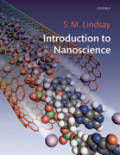
Nanoscience is not physics, chemistry, engineering or biology. It is all of them, and it is time for a text that integrates the disciplines. This is such atext, aimed at advanced undergraduates and beginning graduate students in thesciences. The consequences of smallness and quantum behaviour are well known and described Richard Feynman's visionary essay 'There's Plenty of Room at theBottom' (which is reproduced in this book). Another, critical, but thus far neglected, aspect of nanoscience is the complexity of nanostructures. Hundreds,thousands or hundreds of thousands of atoms make up systems that are complex enough to show what is fashionably called 'emergent behaviour'. Quite new phenomena arise from rare configurations of the system. Examples are the Kramer's theory of reactions (Chapter 3), the Marcus theory of electron transfer (Chapter 8), and enzyme catalysis, molecular motors, and fluctuations in gene expression and splicing, all covered in the final Chapter on Nanobiology. The book is divided into three parts. Part I (The Basics) is a self-contained introduction to quantum mechanics, statistical mechanics and chemical kinetics, callingon no more than basic college calculus. A conceptual approach and an array ofexamples and conceptual problems will allow even those without the mathematical tools to grasp much of what is important. Part II (The Tools) covers microscopy, single molecule manipulation and measurement, nanofabrication and self-assembly. Part III (Applications) covers electrons in nanostructures, molecularelectronics, nano-materials and nanobiology. Each chapter starts with a survey of the required basics, but ends by making contact with current research literature. INDICE: 1: What is nanoscience? Part I: The Basics 2: Quantum mechanics 3:Statistical mechanics and chemical kinetics Part II: Tools 4: Microscopy and manipulation tools 5: Making nanostructures: top down 6: Making nanostructures: bottom up Part III: Applications 7: Electrons in nanostructures 8: Molecularelectronics 9: Nanostructured materials
- ISBN: 978-0-19-954421-9
- Editorial: Oxford University
- Encuadernacion: Rústica
- Páginas: 457
- Fecha Publicación: 01/10/2009
- Nº Volúmenes: 1
- Idioma: Inglés
